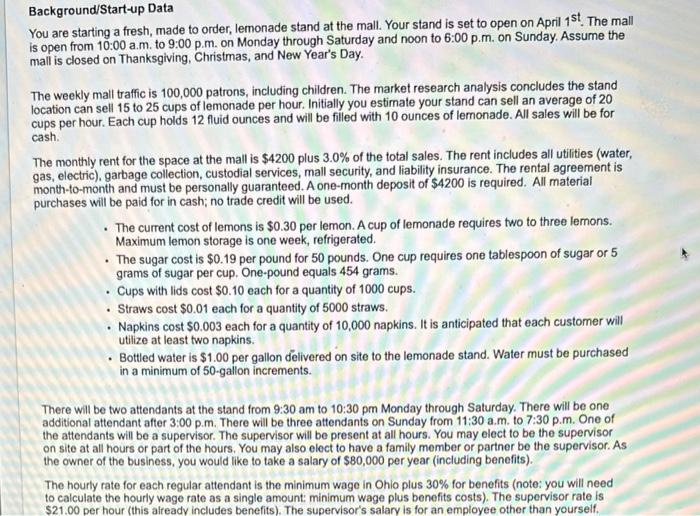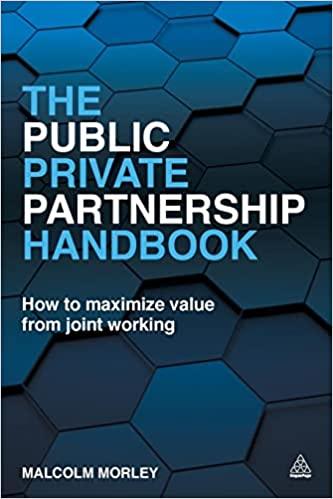You are starting a fresh, made to order, lemonade stand at the mall. Your stand is set to open on April 1st. The mall is open from 10:00 a.m. to 9:00p.m. on Monday through Saturday and noon to 6:00 p.m. on Sunday. Assume the mall is closed on Thanksgiving, Christmas, and New Year's Day. The weekly mall traffic is 100,000 patrons, including children. The market research analysis concludes the stand location can sell 15 to 25 cups of lemonade per hour. Initially you estimate your stand can sell an average of 20 cups per hour. Each cup holds 12 fluid ounces and will be filled with 10 ounces of lemonade. All sales will be for cash. The monthly rent for the space at the mall is $4200 plus 3.0% of the total sales. The rent includes all utilities (water, gas, electric), garbage collection, custodial services, mall security, and liability insurance. The rental agreement is month-to-month and must be personally guaranteed. A one-month deposit of $4200 is required. All material purchases will be paid for in cash; no trade credit will be used. - The current cost of lemons is $0.30 per lemon. A cup of lemonade requires two to three lemons. Maximum lemon storage is one week, refrigerated. - The sugar cost is $0.19 per pound for 50 pounds. One cup requires one tablespoon of sugar or 5 grams of sugar per cup. One-pound equals 454 grams. - Cups with lids cost $0.10 each for a quantity of 1000 cups. - Straws cost $0.01 each for a quantity of 5000 straws. - Napkins cost $0.003 each for a quantity of 10,000 napkins. It is anticipated that each customer will utilize at least two napkins. - Bottled water is $1.00 per gallon delivered on site to the lemonade stand. Water must be purchased in a minimum of 50-gallon increments. There will be two attendants at the stand from 9:30 am to 10:30pm Monday through Saturday. There will be one additional attendant after 3:00 p.m. There will be three attendants on Sunday from 11:30 a.m. to 7:30 p.m. One of the attendants will be a supervisor. The supervisor will be present at all hours. You may elect to be the supervisor on site at all hours or part of the hours. You may also elect to have a family member or partner be the supervisor. As the owner of the business, you would like to take a salary of $80,000 per year (including benefits). The hourly rate for each regular attendant is the minimum wage in Ohio plus 30% for benefits (note: you will need to calculate the hourly wage rate as a single amount: minimum wage plus benefits costs). The supervisor rate is $21.00 per hour (this already includes benefits). The supervisor's salary is for an employee other than yourself. There will be two attendants at the stand from 9:30 am to 10:30pm Monday through Saturday. There will be one additional attendant after 3:00 p.m. There will be three attendants on Sunday from 11:30 a.m. to 7:30 p.m. One of the attendants will be a supervisor. The supervisor will be present at all hours. You may elect to be the supervisor on site at all hours or part of the hours. You may also elect to have a family member or partner be the supervisor. As the owner of the business, you would like to take a salary of $80,000 per year (including benefits). The hourly rate for each regular attendant is the minimum wage in Ohio plus 30% for benefits (note: you will need to calculate the hourly wage rate as a single amount: minimum wage plus benefits costs). The supervisor rate is $21.00 per hour (this already includes benefits). The supervisor's salary is for an employee other than yourself. The cost of the capital equipment for setting up the stand is $250,000 which includes all equipment, counters, signage, refrigerators, ice-machine, and cash register. This equipment can be purchased with $50,000cash and a bank loan for the remainder. You will need to determine the bank loan terms for the remainder amount- the annual interest and monthly payments for 5 years. You are to assume that the monthly loan payment will be $XXXX amount, broken down as $X interest each month and $X on the loan principal balance. The equipment is to be depreciated on a straight-line basis (no salvage value) over the 7 years of its estimated life. Note: "free" loans where you do not have to make payments for X-years on the loan are not to be used. A. Starting (Opening) Balance Sheet (time zero) Create a Balance Sheet showing starting Assets, Liabilities, and Shareholder's Equity. The assets will include cash, equipment, inventory, etc. The long-term liabilities will include the bank loan. The shareholder's equity will include starting capital which must be sufficient to purchase starting inventory, pay employees and rent for the first 2 months, pay the $4200 rental deposit, pay $50,000 for the equipment, and make payments on the equipment loan for the first year. The equity is your cash investment in the business and may come from your personal savings, personal investments, from your family and friends, a second mortgage on your home, or your kids' piggy banks. It may also partially come from a partner or partners. The cash investment will be shown as Shareholder's Equity on the Balance Sheet. Some of this cash will be spent on equipment ($50,000), starting inventory, rent deposit ($4200). etc. The remainder will appear as cash on hand on the Balance Sheet to help cover the monthly expenses going forward








